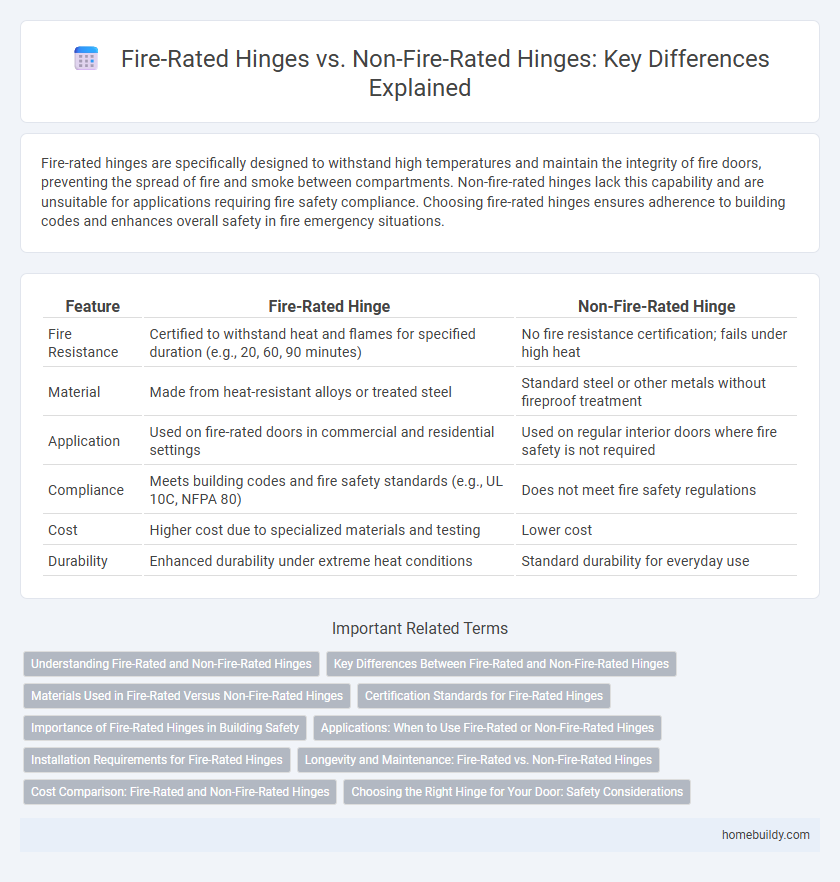Fire-rated hinges are specifically designed to withstand high temperatures and maintain the integrity of fire doors, preventing the spread of fire and smoke between compartments. Non-fire-rated hinges lack this capability and are unsuitable for applications requiring fire safety compliance. Choosing fire-rated hinges ensures adherence to building codes and enhances overall safety in fire emergency situations.
Table of Comparison
| Feature | Fire-Rated Hinge | Non-Fire-Rated Hinge |
|---|---|---|
| Fire Resistance | Certified to withstand heat and flames for specified duration (e.g., 20, 60, 90 minutes) | No fire resistance certification; fails under high heat |
| Material | Made from heat-resistant alloys or treated steel | Standard steel or other metals without fireproof treatment |
| Application | Used on fire-rated doors in commercial and residential settings | Used on regular interior doors where fire safety is not required |
| Compliance | Meets building codes and fire safety standards (e.g., UL 10C, NFPA 80) | Does not meet fire safety regulations |
| Cost | Higher cost due to specialized materials and testing | Lower cost |
| Durability | Enhanced durability under extreme heat conditions | Standard durability for everyday use |
Understanding Fire-Rated and Non-Fire-Rated Hinges
Fire-rated hinges are engineered to withstand high temperatures and maintain door integrity during a fire, ensuring compliance with safety codes and preventing the spread of flames and smoke. Non-fire-rated hinges lack this capability, making them unsuitable for use in fire-resistant doors or environments requiring rigorous fire protection standards. Selecting fire-rated hinges is critical for buildings aiming to meet fire safety regulations and enhance occupant protection.
Key Differences Between Fire-Rated and Non-Fire-Rated Hinges
Fire-rated hinges are specifically designed to withstand high temperatures and maintain door integrity during a fire, typically tested to meet UL 10C or NFPA 80 standards. Non-fire-rated hinges lack this thermal resistance and certification, making them unsuitable for use in fire doors where safety codes require fire containment. The key differences include material composition, temperature tolerance, and compliance with fire safety regulations essential for building safety compliance.
Materials Used in Fire-Rated Versus Non-Fire-Rated Hinges
Fire-rated hinges are typically constructed from heavy-duty materials such as stainless steel or galvanized steel, designed to withstand extreme heat and maintain door integrity during a fire. Non-fire-rated hinges often use lighter metals like brass or standard steel, which lack the thermal resistance and strength required for fire safety. The material composition directly impacts the hinge's ability to support fire-resistant doors and comply with safety regulations.
Certification Standards for Fire-Rated Hinges
Fire-rated hinges comply with stringent certification standards such as UL 10C and NFPA 80, ensuring doors withstand fire exposure and maintain integrity for a specified duration, typically 20 to 90 minutes. These certifications guarantee that fire-rated hinges undergo rigorous testing to meet performance requirements for temperature resistance, durability, and mechanical strength during fire conditions. In contrast, non-fire-rated hinges lack such certifications and do not provide tested protection against fire, making them unsuitable for fire door applications.
Importance of Fire-Rated Hinges in Building Safety
Fire-rated hinges are essential components in fire-resistant doors, designed to maintain door integrity and prevent the spread of flames and smoke during a fire. Unlike non-fire-rated hinges, these hinges undergo rigorous testing to comply with safety standards such as UL 10C and NFPA 80, ensuring they function under extreme heat conditions. Incorporating fire-rated hinges enhances overall building safety by providing critical time for evacuation and limiting fire damage.
Applications: When to Use Fire-Rated or Non-Fire-Rated Hinges
Fire-rated hinges are essential for applications requiring enhanced safety and compliance with building codes, especially in commercial buildings, hospitals, and schools where fire doors must prevent the spread of flames and smoke. Non-fire-rated hinges suit residential or interior doors where fire resistance is not a critical factor, focusing on ease of movement and aesthetics rather than fire protection. Selecting the appropriate hinge depends on the door's location, fire safety requirements, and regulatory standards.
Installation Requirements for Fire-Rated Hinges
Fire-rated hinges must be installed in compliance with stringent building codes and fire safety standards to ensure effective performance during a fire event. Installation requires precise alignment, use of approved fasteners, and often a minimum number of hinges per door, typically three or more, to maintain fire resistance integrity. Non-fire-rated hinges lack these specific requirements, making fire-rated hinges essential for doors in fire-rated assemblies.
Longevity and Maintenance: Fire-Rated vs. Non-Fire-Rated Hinges
Fire-rated hinges are constructed from durable materials such as stainless steel or heavy-duty alloys, providing enhanced longevity and resistance to wear under extreme conditions. These hinges require minimal maintenance due to their corrosion-resistant coatings and robust design, ensuring reliable performance in fire safety applications. Non-fire-rated hinges often demand more frequent inspections and upkeep, as they lack the specialized treatments that protect against heat and environmental damage.
Cost Comparison: Fire-Rated and Non-Fire-Rated Hinges
Fire-rated hinges typically cost 30% to 50% more than non-fire-rated hinges due to their enhanced materials and rigorous testing standards required for fire resistance. Non-fire-rated hinges, made from standard steel or stainless steel, offer a more budget-friendly solution but lack certification for use in fire doors. Investing in fire-rated hinges is crucial for compliance with building codes and safety regulations in fire-risk areas, justifying the higher initial expenditure.
Choosing the Right Hinge for Your Door: Safety Considerations
Fire-rated hinges are designed to withstand high temperatures and maintain door integrity during a fire, ensuring life safety and property protection. Non-fire-rated hinges lack this capability and may fail under fire conditions, compromising the door's function as a barrier. Selecting a fire-rated hinge is essential for compliance with building codes and enhances the door's ability to contain fire and smoke.
fire-rated hinge vs non-fire-rated hinge Infographic

 homebuildy.com
homebuildy.com